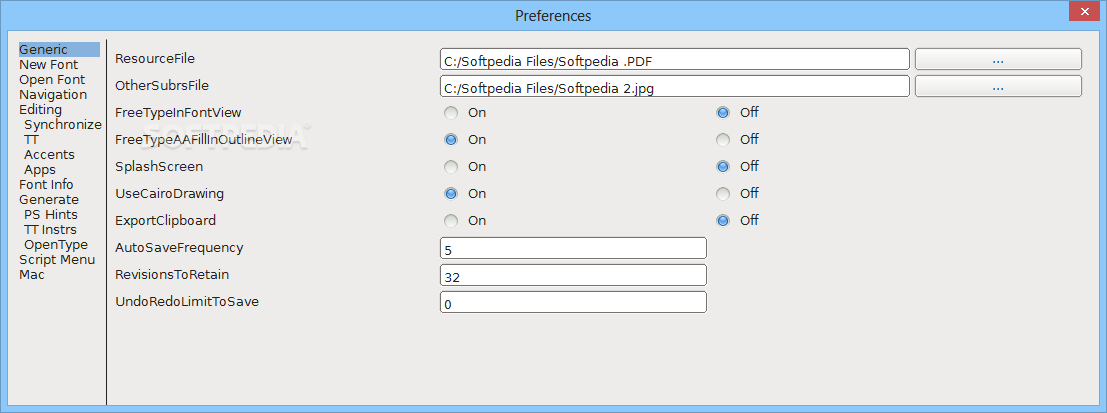
- Fontforge baseline mac os#
- Fontforge baseline software#
- Fontforge baseline trial#
- Fontforge baseline windows 7#
I have not changed any settings in FontForge, so the Options window just shows defaults.Īfter validating, an error shows up saying that “the font contains errors”: I only force glyph names to Validate Before Saving.

I then export/generate the font through File → Generate Fonts., where I'll select a fontname, say comic2.ttf, where I'll set options: TrueType, No Bitmap Fonts and No Rename. In the new window I can save the font as say, comic2.sfd. Afterwards, I save the font as a FontForge file (just to be sure) through File → Save as. I move an anchor point to a random location (you can change two anchor points to be sure). To edit the glyph, I open up FontForge¹ and double click any glyph. I can change any glyph, say the capital letter A.

The problem persists.įor reproducability, consider Comic Sans (which I believe comes with any Windows distribution): a TrueType-flavoured OpenType font. I've already tried changing the font cache, reinstalling everything (Windows included), or trying different fonts, glyphs, and so on.
Fontforge baseline windows 7#
I can reproduce the problem on both of my Windows 7 systems (laptop/PC), I can reproduce the problem with either of two pieces of font editing software. I've tried changing some things around a bit. Converting the OpenType file to readable font metrics for my typesetting software, the wrong glyph shows up in the glyph table. FontExplorer does not show the edited glyph, while Suitcase Fusion does show the new glyph. However, something strange happens when I check the font in the font management software.
Fontforge baseline software#
(The final product is to be a math font for use with the TeX typesetting system.)Įditing any font is correctly reflected in both pieces of font editing software (Studio as well as FF).
Fontforge baseline trial#
To check how the new font looks, I also have trial versions of I therefore decided altering the glyph slightly to show a longer extension from the baseline (I hope it's clear what I mean with this).Īfter doing some research, I have the following software at my disposal for changing the glyph: In a font I recently bought, a glyph is too small for my liking. Unix apps will probably choose one of the above.I'm unsure whether this is the right place to ask this kind of thing but honestly, I'm at wit's end here, so I'll try anything. Unfortunately Windows programs rarely follow the standard (which I expect doesn't supprise anyone), and generally they will use the font's bounding box as specified in the Win Ascent/Descent fields of the 'OS/2' table.

These can be set with element- >FontInfo->OS/2, but are usually allowed to default to the Ascent and Descent values of FontForge - they generally sum to 1em and are equivalent to the traditional unleaded default.Īgain this may be modified by a linegap field. On a mac the baseline to baseline spacing is determined again by the bounding box values of the font, specified in the 'hhea' table, possibly modified by a linegap (Which you can set in FontForge with Element->FontInfo->OS/2.Īccording to the OpenType spec, the baseline to baseline distance is set by the values of Typographic Ascent and Descent of the 'OS/2' table. Unfortunately this depends on the platform Without useless space at the top and not clipped: The highlighted character in MS Word shows the correct solution. I think this abnormally free space at the top of the character could be the reason for the different font size, If you set the same Ysize on Windows and MAC:

Fontforge baseline mac os#
(PS: and you can see the smoother and better font rendering engine on Mac OS ) On Mac OS there is a somewhat oversized space at the top of the character ( Bug?) On Windows the character is clipped at the left and right side ( Bug?)ģ. To get the same character size and character width, you have to set a higher Ysize on Mac OS (42 vs. SaveImage(#image, "fonttest_" + #sys + ".png", #PB_ImagePlugin_PNG)ġ. LoadFont(#font, "Matura MT Script Capitals", #size, #PB_Font_HighQuality)ĬreateImage(#image, 128, 128, 32, $FF00FFFF)ĭrawingMode(#PB_2DDrawing_Transparent | #PB_2DDrawing_AlphaBlend) CompilerCase #PB_OS_Windows: #sys = "win": #size = 42 Different Sizes to get the same Width()ĬompilerCase #PB_OS_MacOS : #sys = "mac": #size = 57 Different Sizes to get the same Width()


 0 kommentar(er)
0 kommentar(er)
